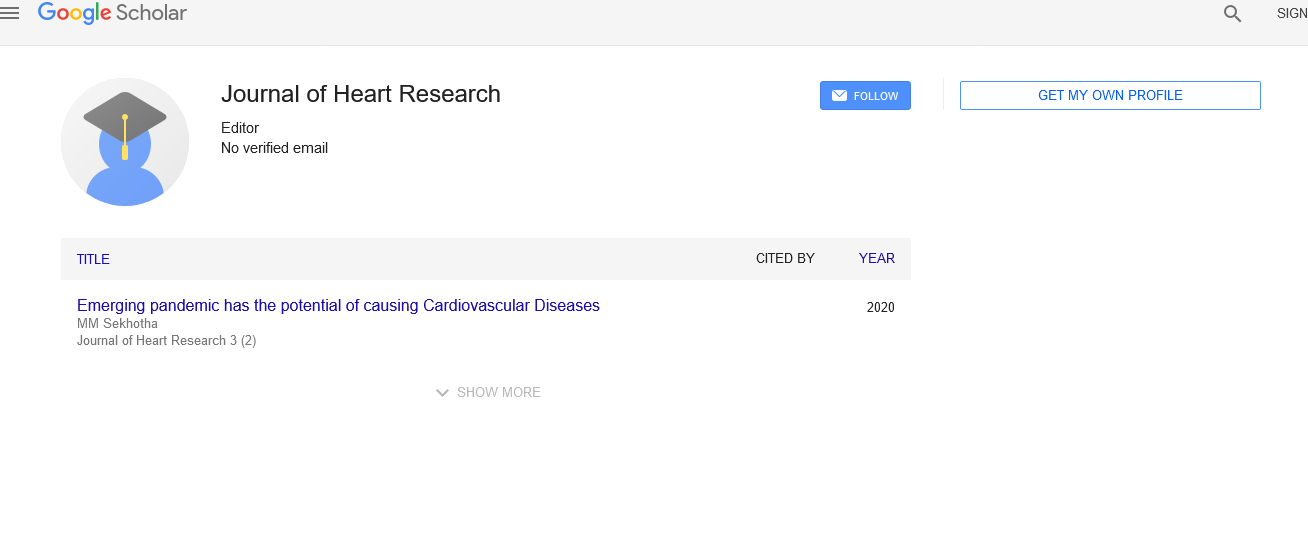A rare symptom of expanded dengue syndrome is dengue myocarditis that causes acute cardiac failure
Received: 26-Sep-2022, Manuscript No. puljhr-22-5542; Editor assigned: 28-Sep-2022, Pre QC No. puljhr-22-5542 (PQ); Accepted Date: Oct 21, 2022; Reviewed: 11-Oct-2022 QC No. puljhr-22-5542 (Q); Revised: 18-Oct-2022, Manuscript No. puljhr-22-5542 (R); Published: 25-Oct-2022, DOI: 10.37532/ puljhr.2022.5(5).01-03
Citation: John A. A rare symptom of expanded dengue syndrome is dengue myocarditis that causes acute cardiac failure. Int J. Heart Res. 2022; 5(5):1-3.
This open-access article is distributed under the terms of the Creative Commons Attribution Non-Commercial License (CC BY-NC) (http://creativecommons.org/licenses/by-nc/4.0/), which permits reuse, distribution and reproduction of the article, provided that the original work is properly cited and the reuse is restricted to noncommercial purposes. For commercial reuse, contact reprints@pulsus.com
Abstract
Tropical and subtropical regions of the world frequently experience dengue, a virus spread by arthropods. Clinical signs of the disease include asymptomatic infections, undifferentiated fever, dengue fever, which causes a fever, headache, retroorbital pain, myalgia, and arthralgia, and a severe version known as dengue hemorrhagic fever/dengue shock syndrome, which causes hemoconcentration, thrombocytopenia, and bleeding tendency. Myocarditis is the most prevalent form of the cardiac problem associated with dengue that is now being detected more frequently. Although both direct viral infection and immune-mediated damage have been proposed as the causes of myocardial injury in dengue myocarditis, the primary mechanism is still uncertain. Because it is asymptomatic and difficult to diagnose, dengue myocarditis occurs seldom. Dengue myocarditis is almost always self-limiting, and it is very uncommon for the condition to progress to a severe myocarditis that results in dilated cardiomyopathy. Acute myocarditis as well as dengue hemorrhagic fever were both identified in the patient. Five days of treatment led to a better state. Myocarditis is the most prevalent form of the cardiac problem associated with dengue that is now being detected more frequently. Although both direct viral infection and immune-mediated damage have been proposed as the causes of myocardial injury in dengue myocarditis, the primary mechanism is still uncertain. Because it is asymptomatic and difficult to diagnose, dengue myocarditis occurs seldom. Dengue myocarditis is almost always self-limiting, and it is very uncommon for the condition to progress to a severe myocarditis that results in dilated cardiomyopathy. A case of dengue hemorrhagic fever with myocarditis as a symptom has been reported. A supportive management approach helps the condition.
Keywords
Acute heart failure; Acute myocarditis;, Cardiomyopath; Dsengue fever
INTRODUCTION
A n important public health issue, dengue is a human arthropodborne virus infection that is endemic to tropical and subtropical areas of the world. By the bite of an Aedes aegypti mosquito carrying one of the four dengue virus serotypes, such as dengue, dengue viruses are spread. Since it is now easier to travel the world, dengue disease has geographically spread to many formerly untouched places, and doctors in temperate regions are more likely to see returning travelers with the virus. Expanded dengue syndrome is a new term that has been added to the classification system to encompass a wide range of unusual dengue infection manifestations that have been reported to affect various organ systems, including the gastrointestinal, hepatic, neurological, cardiac, pulmonary, and renal systems. It's noteworthy that dengue has been linked to a number of heart problems [1]. Dengue is typically a self-limiting, low-mortality flu-like infection that can be asymptomatic. The hallmark of DF is the sudden development of fever, which is frequently, accompanied by other symptoms such a strong headache, pain behind the eyes, joint pain, nausea, vomiting, abdominal pain, and lack of appetite
Poorer outcomes have been linked to two different clinical entities, Dengue Hemorrhagic Fever (DHF) and Dengue Shock Syndrome (DSS). But despite the persistent division of dengue into DF, DHF, and DSS, the overlap between the various symptoms may be seen. The symptoms of dengue are fever, headache, retro-orbital discomfort, myalgia, nausea, vomiting, skin rash, leukopenia, and thrombocytopenia which may or may not be accompanied by plasma leakage [2]. DSS can also become complicated by the involvement of other organs as the liver, kidneys, heart, and brain. In addition to the typical classical appearance, dengue infection can cause a variety of atypical clinical symptoms that are together referred to as "Expanded Dengue Syndrome" (EDS) [3]. Atrioventricular conduction abnormalities, supraventricular arrhythmia, and myocarditis are among the affected patients. Myocarditis is the most frequent side effect. There is a severe paucity of knowledge regarding myocarditis in dengue. It is still unclear what causes myocarditis in dengue. Dengue myocarditis has a variety of clinical manifestations. EMB is a deterministic diagnostic technique that has had trouble gaining acceptance. The combination of symptoms, electrocardiography, cardiac enzyme markers, and cardiac imaging can be used to diagnose a patient with dengue hemorrhagic fever who has myocarditis, according to the ESC (European Society of Cardiologists) New Criteria. Arrhythmias, heart failure, and cardiogenic shock are the deadly dengue myocarditis consequences [4].
Methodology
The defining feature of DF is a quick onset of fever, which is frequently accompanied by other symptoms like lack of appetite, nausea, vomiting, a strong headache, discomfort behind the eyes, joint pain, and pain in the muscles and bones. Poorer outcomes have been connected to two different clinical entities, DHF and DSS. The overlap between the various manifestations may be seen despite the persistent categorization of dengue as DF, DHF, and DSS End organ damage, such as liver, kidney, heart, brain, and bone marrow involvement, has primarily been described in severe dengue with bleeding or plasma leakage, which may cause doctors to be uncertain if this end-organ damage is a component of dengue shock or EDS. They might be connected to underlying co-morbid conditions, related co-infections, or protracted shock. Pregnant women, young children, elderly people, patients with coronary artery disease, hemoglobinopathies, and people with impaired immune systems are all high-risk categories that are especially prone to developing EDS. Clinicians need to be aware of these unusual symptoms so they may identify dengue quickly, especially when epidemics are continuing [5].
At the patient's bedside, an emergency transthoracic echocardiogram revealed a minor pericardial effusion, no indications of cardiac tamponade, a dilated left ventricle, and diffuse left ventricular wall hypokinesia. The interventricular septum was healthy. As a result, the enlarged dengue syndrome was diagnosed as having dengue hemorrhagic fever together with dengue myocarditis and acute pulmonary edoema. The absence of precise definitional criteria for cardiac involvement presents the biggest challenge in defining the signs and symptoms of cardiac involvement in dengue. There have been reports of severe dengue cases causing hypotension, shock, arrhythmias, and pulmonary edoema. As a result of plasma leakage and tissue hypoperfusion, individuals with severe dengue may experience significant hemodynamic and homeostatic abnormalities [6].
Determining cardiac involvement in dengue is difficult
Arrhythmias could develop as a result of metabolic disturbances, which include aberrant sodium, potassium, and calcium levels that are found in severe dengue shock. As a result, it might be challenging to distinguish between main cardiac involvement and secondary cardiac consequences. In the past, cardiac involvement may have been underreported as a result. Clinical characteristics, electrocardiographi c abnormalities, aberrant cardiac biomarkers, and echocardiographic results have all been examined in diverse investigations as potential indicators of cardiac involvement in dengue [7]. The majority of severe dengue cases are associated with two well-known pathophysiologic hallmarks, plasma leakage, and bleeding, which result in shock and death. Normal dengue cases are mild to moderate in severity.
Although the underlying causes of a severe form of dengue are not entirely understood, there is a strong correlation between severe dengue and various serotypes as well as an immune-mediated response. T-cell-mediated and antibody-dependent pathways have both been linked to severe dengue. Cross-reactive T cells and antibodies have been shown to play a significant role in the development of subsequent dengue infections. The pathogenesis of severe dengue has also been accelerated by pro-inflammatory cytokines, which cause endothelial dysfunction and high levels of enhancing antibodies [8].
DISCUSSION
Fever and pain in the muscles and joints are the main symptoms of dengue virus infection, which can affect both children and adults. The pain typically gets worse after the first three days. In children under the age of 15, this illness is a severe febrile illness with bleeding symptoms that can be frightening. Adults are less likely to be affected by this illness, but it can cause mortality in youngsters. Heartburn, weakness, tiredness, anxiety, and evidence of bleeding in the skin (petechiae), bruising (ecchymosis), or rash are symptoms of this illness. A sudden high fever lasting 2 days to 7 days without a clear explanation is another clue (purpura). Other spontaneous bleeding symptoms, like nosebleeds, gum bleeding, and diarrhoea, can also occur occasionally. Unconsciousness or shock may result from severe symptoms. An asymptomatic DF, DHF, or DSS may be a sign of dengue infection. Cases that do not fit into either dengue shock syndrome or dengue hemorrhagic fever are referred to as having "expanded dengue syndrome." The most frequent symptoms are those related to the heart and the nervous system, and dengue encephalitis is a major factor in the fatal outcome. The practical understanding of EDS aids in the diagnosis and prompts the proper course of treatment for dengue with atypical characteristics. Clinicians need to be aware of these unique symptoms so they can recognize dengue quickly, especially when epidemics are continuing [9].
Laboratory findings for dengue fever include thrombocytopenia, which is a symptom of plasma and represents 20% of the baseline on dengue hemorrhagic fever. The primary/first, secondary/reinfection or other kinds of dengue infection affects the outcome of serological tests for dengue. Due to their delayed appearance, IgM antibodies are typically undetectable for the first five days of a clinical disease. IgM antibodies are detectable by 3 days-5days after the onset of sickness, climb significantly in two weeks, and then drop to undetectable levels after two to three months. In dengue secondary infection, IgM levels are not as high as in initial infection and are occasionally completely missing or undetectable
References
- Rigau-Pérez JG. Severe dengue: the need for new case definitions. Lancet infect dis. 2006;6(5):297-302.
- Prabhakar S, Kumar CB. Study of Cardiac Manifestation of Dengue Fever in Children Less Than 12 Years Age. Eur J Mol Clin Med. 2021;8(04):2021.
- Gurugama P, Garg P, Perera J, et al. Dengue viral infections. Indian j dermatol. 2010;55(1):68.
- Saha A, Bandyopadhyay T, Mukhopadhyay M, et al. Different Presentations of Expanded Dengue Syndrome: A Case Series and Review of Literature. Bengal Physician J. 2021;8(2):52-6.
- Umakanth M. Dengue fever complicated with Non-STEMI. Saudi J Med Pharm Sci. 2017;3:704-6.
- Garcıa-Martıneza CE, Liblikb K, Araiza-Garaygordobilh D, et al. The NET-Heart Book: Neglected Tropical Diseases and other Infectious Diseases affecting the Heart. 2021; 12:205.
[Google scholar] [Cross Ref]
- Abrar S, Ansari MJ. Acute fulminant myocarditis in a case of dengue fever: A case report. Asian Pac J Trop Dis., 2016 Apr 1;6(4):328-9.
- Verma R, Sahu R, Holla V, et al. Neurological manifestations of dengue infection: a review. J neurol sci., 2014;346(1-2):26-34.
- Halstead S, Wilder-Smith A. Severe dengue in travellers: pathogenesis, risk and clinical management. J travel med. 2019;26(7):062.





